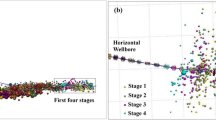Abstract
The complex morphology of hydraulic fractures has been reported in layered formations due to the frequent occurrence of bedding. The success of hydraulic fracturing heavily depends on the vertical growth of hydraulic fractures. However, hydraulic fracture propagation in laminated rocks poses a complex problem due to the heterogeneity of the formations and bedding plane properties. This study employs a 3D finite element modeling considering bedding plane properties to simulate hydraulic fracture propagation in multi-lithologic interbedded strata and then validate the results with laboratory experiments. The hydromechanical coupled model proposed in this paper accounting for contact types, bedding friction coefficient and conductivity, rock layer distribution, stress and viscous fluid flow, which can well simulate the mutual interaction between hydraulic fractures and bedding planes. Numerical predictions are in good agreement with true triaxial fracturing experiments conducted. According to the numerical simulation and experiments results, the hydraulic fracture can exhibit one of the following behaviors: it may pass through the interface directly, extend along the interface after turning, or stop before reaching the interface. The results indicate that higher overburden pressure promotes the cross-layer propagation of hydraulic fractures. Only when the coefficient of variation between the vertical stress and the minimum horizontal stress reaches a certain threshold can the fracture penetrate the bedding. Hydraulic fractures may be arrested at the interface due to weak bedding strength or roughness. In the presence of multiple interfaces, hydraulic fractures may propagate along weakly-bonded interfaces with conductivity, which can lead to a decrease in the effective fracture area and a reduced efficiency of hydraulic fracturing. This study conducts further investigations and discussions on the influence of parameters, such as interlayer roughness and strength, interface permeability, on the fracture propagation. This research can provide insights into the mechanics of hydraulic fracture propagation in layered rocks and contribute to the development of unconventional reservoirs with more effective hydraulic fracturing techniques.
Access this chapter
Tax calculation will be finalised at checkout
Purchases are for personal use only
Similar content being viewed by others
References
Mi, L., Zhu, G.: Geological characteristics and exploration breakthrough in Linxing-Shenfu tight gas field, northeastern Ordos Basin. China Petrol. Explor. 26(3), 53–67 (2021)
Warpinski, N.R., Tyler, L.D., Vollendorf, W.C., Northrop, D.A.: Direct observation of a sand-propped hydraulic fracture. United States (1981)
Huang, B., Liu, J.: Experimental investigation of the effect of bedding planes on hydraulic fracturing under true triaxial stress. Rock Mech. Rock Eng. (2017)
Athavale, A.S., Miskimins, J.L.: Laboratory Hydraulic Fracturing Tests on Small Homogeneous and Laminated Blocks. ARMA-08-067 (2008)
Casas, L., Miskimins, J.L., Black, A., Green, S.: Laboratory hydraulic fracturing test on a rock with artificial discontinuities. In: LSPE Annual Technical Conference and Exhibition (2006)
Suarez-Rivera, R., Connor, B., Kieschnick, J., Green, S.: Hydraulic fracturing experiments help understanding fracture branching on tight gas shales. In: Proceedings of the 41st U.S. Rock Mechanics Symposium—ARMA’s Golden Rocks 2006—50 Years of Rock Mechanics (2006)
Teufel, L.W., Clark, J.A.: Hydraulic fracture propagation in layered rock: experimental studies of fracture containment. Soc. Petrol. Eng. J. 24(01), 19–32 (1984)
Hou, B., Zhu, P., Xu, D., Yao, Z., Li, Z., Chen, M., Zhou, Z.: Experimental investigation of longmaxi shale core: hydraulic fracture initiation and propagation in vertical plane. In: 5th ISRM Young Scholars' Symposium on Rock Mechanics and International Symposium on Rock Engineering for Innovative Future, Okinawa, Japan (2019)
Wang, T., Chen, M., Wu, J., Lu, J., Luo, C., Ju, Y.: Experimental study on the hydraulic fracture behavior when meeting large particle, layer interface and natural fractures. In: Abu Dhabi International Petroleum Exhibition & Conference, Abu Dhabi, UAE (2020)
Chen, J., Li, X., Cao, H., Huang, L.: Experimental investigation of the influence of pulsating hydraulic fracturing on pre-existing fractures propagation in coal. J. Petrol. Sci. Eng. 189, 107040 (2020)
Tang, J., Zuo, L., **ao, L., Wu, K., Qian, B., Yin, C., Ehlig-Economides, C., You, X.: A 3D hydraulic fracture propagation model applied for multiple-layered formation. 2019(3), 1–21 (2019)
**e, J., Tang, J., Yong, R., Fan, Y., Zuo, L., Chen, X., Li, Y.: A 3-D hydraulic fracture propagation model applied for shale gas reservoirs with multiple bedding planes. Eng. Fract. Mech. 228, 106872 (2020)
Huang, B., Liu, J.: Fully three-dimensional propagation model of horizontal borehole hydraulic fractures in strata under the effect of bedding planes. Energy Explor. Exploit. 36(5), 1189–1209 (2018)
Wan, C.: Mechanism of hydraulic fracture propagation in fractured shale reservoir in three dimensional space. Ph.D. thesis in China University of Petroleum, Bei**g (2016)
Taleghani, A.D.: Analysis of hydraulic fracture propagation in fractured reservoir: an improved model for the interaction between induced and natural fractures. Ph.D. thesis in the University of Texas at Austin (2009)
Pengju, X., Keita, Y., Jose, A., Amr, E.-F., Bunger, A.P.: Laboratory demonstration of hydraulic fracture height growth across weak discontinuities. Geophysics 83(2), MR93–MR105 (2018)
Author information
Authors and Affiliations
Corresponding author
Editor information
Editors and Affiliations
Rights and permissions
Copyright information
© 2024 The Author(s), under exclusive license to Springer Nature Switzerland AG
About this paper
Cite this paper
Wang, F. et al. (2024). Hydraulic Fracture Propagation in Layered Rocks: Research Combining 3D FEM Modeling and Laboratory Experiments. In: Li, S. (eds) Computational and Experimental Simulations in Engineering. ICCES 2023. Mechanisms and Machine Science, vol 145. Springer, Cham. https://doi.org/10.1007/978-3-031-42987-3_35
Download citation
DOI: https://doi.org/10.1007/978-3-031-42987-3_35
Published:
Publisher Name: Springer, Cham
Print ISBN: 978-3-031-42986-6
Online ISBN: 978-3-031-42987-3
eBook Packages: EngineeringEngineering (R0)




